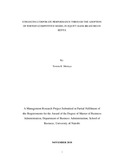| dc.description.abstract | The banking industry in Kenya has undergone a lot of changes since the early 1990s from a high level of regulation to a more liberalized environment with less government interference. Consequently, there have been changes in the political and socio-economic environment which is threatening the status quo and to which the banks must respond in order to sustain their profitability. Globalization describes the ongoing global trend towards the free flow of trade and investment across borders and resulting integration of the international economy. Globalization brought about the convergence of markets whereas liberalization of economies of various countries encouraged free markets. This poses a challenge to managers to ensure that organizations adopt the best strategies for survival in such a competitive environment. As a result, organizations have to continuously adapt their activities in order to survive in the current turbulent environment that is constantly changing. This implies that organizations should formulate and implement strategies that will enable them beat competition and sustain growth. The study sought out to establish whether the various branches of Equity bank have adopted Porter‟s competitive model and also to establish whether the various branches of Equity bank in different regions of the country have enhanced the overall performance of the bank through the adoption of Porter‟s competitive model. The data was collected through questionnaires administered through drop and pick later approach as well as mailed questionnaires approach to 25 branches. 3 questionnaires were sent to each branch giving a total of 75 respondents.
The findings of the study indicate that the most popular type of strategy was on the basis of differentiation. The approach that was mainly used at the branch level was targeting a specific market segment and offering many product lines with strong emphasis on the unique feature for each type of product made for each segment of customers. This shows that the focus is on giving a unique and distinct product or service hence the differentiation strategy was mainly narrow focus in relation to broad focus differentiation strategy. Differentiation aspects such as use of corporate image of the firm as a selling point, building features that meet specific needs of customers and strong cooperation from channels were ranked
ix
highest as the most commonly used differentiation aspect by respondents from various branches. Cost leadership was a less popular strategy at the branch level due to the fact that most cost control activities are centralized and more so due to the nature of the industry. In the banking industry, very low cost services are mainly associated with poor quality service. This is because if adequate resources are not dedicated in those activities then the corporate performance of the bank cannot be enhanced taking into account the competitive nature of the industry where every firm is working its level best and putting in place the best strategies that can enhance the quality of products and services that it provides to its customers in order to attract and maintain its clientele. The study was constrained by time available for data collection hence it was not possible to reach all the branches. However information gotten from the branches that the researcher was able to reach was adequate. Key words: Corporate performance, Adoption, Competitive model and Equity Bank. | en_US |

